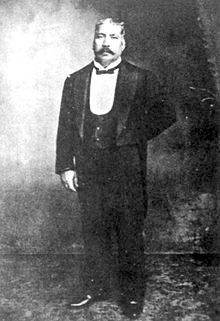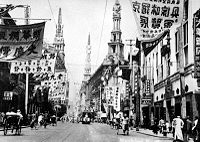Shanghai, China
Silas Aaron Hardoon
From Wikipedia, the free encyclopedia
Silas Aaron Hardoon
Born
1851
Died
1931
Occupation
Businessman, Member Shanghai Municipal Council,
Member Conseil municipale of the French Concession
Silas Aaron Hardoon (1851 – 1931) was a wealthy businessman and well-known public figure in the city of Shanghai in the early 20th century.
Nanking Road in the 1930s
Biography
Silas was born Sileh Hardoon (סאלח חרדון) into a poor Jewish family in Baghdad.[1][2] His family left Baghdad for Mumbai, India where he was educated at a charitable school funded by David Sassoon.
Hardoon traveled to the city of Shanghai, China in 1868 where he entered the employ of David Sassoon, Sons & Company as a rent collector and watchman. He rose quickly through the ranks of that company, displaying a talent for real estate. After leaving that company he expanded his interests into cotton, becoming a partner in E. D. Sassoon's and Company. Shrewd investments, particularly in properties on Shanghai's "Fifth Avenue," Nanking Road, eventually made him one of that city's wealthiest inhabitants. During future Chinese leader Mao Zedong's stay in Shanghai during early 1920, Mao lived in a property in today's Anyi Road owned by Hardoon.[3]
Hardoon lived with his Eurasian wife Luo Jialing (née Lisa Roos 1864-1941) in the Ai-li Park, a twenty-six-acre estate, and personally financed the printing of Buddhist writings. When he died in 1931, his personal fortune was estimated to be worth $650,000,000., which now is around $15,187,480,780.00 . At one point he was the richest person in Asia and one of the richest in the world. After Silas died he gave his earnings to the Hardoon family.[4]
References
-
1
^ Betta, Chiara (2002). "Silas Aaron Hardoon (1851-1931): Business, Politics and Philanthropy in Republican Shanghai, 1911-1931". The Scribe. Retrieved 2008-05-27. -
2
^ David, Hardoon (2008). "The Hardoon Family Genealogy website". The Hardoons. Retrieved 2008-09-22. -
3
^ Phillips, Tom (December 28, 2013). "Chairman's old digs a potent symbol of the new revolution". The Daily Telegraph (p. 25). -
4
^ Dong, Stella (2000). Shanghai: The Rise and Fall of a Decadent City. New York, NY: HarperCollins Publishers, Inc. pp. 58–59. ISBN 0-688-15798-X.



